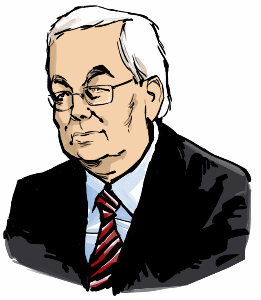Gunnar Tómasson
15. desember 2014.
Introduction
The title of this entry – “Shakespeare” By Another Name” – is that of Mark Andersen’s book published in 2005. In a Foreword to it, the British actor Sir Derek Jacobi writes that the author “demonstrates the intense intellectual energy and attention to factual detail that are required to unravel what, to honest minds, is an obvious mystery. [The book] presents the logical, valid, and excitingly precise arguments for recognizing that [the Seventeenth Earl of Oxford, Edward] de Vere, like all writers, drew from his own experiences, interests, accomplishments, education, position, and talents, and recognizable humanity drawn from his own unique life. Just as de Vere uses theatrical phrases and metaphor naturally and easily, so, too, his wide-ranging education and ingrained knowledge of many subjects flow effortlessly through his writing. Contrast this with the lack of any evidence which places a pen in the hand of William of Stratford (except of course on a dubious monument!).
“The great excitement of this seminal work is the precise relationship between de Vere’s life and his art, unveiling many thrilling revelations of how much of himself de Vere put into his characters. This book, with fascinating specificity, suits “the action to the word, the word to the action.” Innumerable instances of de Vere’s experiences, his relationships, his travels, and his unusual circumstances find expression in his plays and poems. “Shakespeare” by Another Name is one of the very best whodunits you will ever read.”
Book’s opening paragraphs
Every author’s life tells a story. According to the conventional biography, William Shakespeare was born in Stratford-upon-Avon in 1564; he moved to London sometime in the late 1580s or early 1590s and soon enjoyed great success as an actor and playwright, authoring some 37 or more plays, 2 epic poems, 154 sonnets, and assorted other verse that have become the crowning works of the English language. He retired to his hometown sometime around 1612, and he died in 1616. Seven years after his death, the first edition of his collected plays appeared in print. Although no authenticated portrait from his lifetime exists, the 1623 folio of Shakespeare’s works features the above image on its opening page.¹
Yet this image and his conventional story have confounded many great minds over the years.
The novelist Henry James remarked in a 1903 letter to a friend that he was “haunted by the conviction that the divine William is the biggest and most successful fraud ever practiced on a patient world.” In Sigmund Freud’s 1927 essay “An Autobiographical Study,” the founding father of modern psychology stated, “I no longer believe that William Shakespeare the actor from Stratford was the author of the works that have been ascribed to him.” Mark Twain published an entire book in 1909 – Is Shakespeare Dead? – that tore the conventional Shakespeare biography in tatters. Walt Whitman told a confidant in 1888: “It is my belief that the Shakespearean plays were written by another hand than Shaksper’s [sic] ….. I do not seem to have any patience with the Shaksper argument: it is all gone for me – up the spout. The Shaksper case is closed.”
Background
In 1984 an earlier monumental book written by Charlton Ogburn – The Mysterious William Shakespeare: The Myth & the Reality – was published setting forth what struck me as a persuasive case for Edward de Vere, Seventeenth Earl of Oxford as “Shakespeare” by Another Name. At the time, my own research had led me to conclude that Sir Francis Bacon was indisputably linked to the “works of Shakespeare”.
Nineteen years passed between de Vere’s death in 1604 and publication of the First folio of the plays of Shakespeare in 1623. My conclusion about Bacon’s role and the powerful case presented by Ogburn for the Earl of Oxford could only be reconciled on the assumption that de Vere had left his “Shakespeare” writings in Bacon’s custody to be amended, edited and augmented prior to publication of the First folio.
The “smoking gun”
Included in Ogburn’s book was a photographic reproduction of de Vere’s only extant reference to his cousin Bacon – a letter written by de Vere to Robert Cecil in 1601. Its atrocious spelling, including the insertion of “&” for “c” in one word is reminiscent of the mangled spelling of the KEY text in Uppsala Edda (See my previous blog, Snorri Sturluson and William Shakespeare).
What I refer to as the “smoking gun” is boldfaced in the text of de Vere’s letter which reads as follows:
20324 = My very good brother, yf my helthe hadd beene to my mynde
20978 = I wowlde have beene before this att the Coorte
31773 = as well to haue giuen yow thankes for yowre presence at the hearinge
25328 = of my cause debated as to have moued her M for her resolutione.
23461 = As for the matter, how muche I am behouldinge to yow
22506 = I neede not repeate but in all thankfulnes acknowlege,
27362 = for yow haue beene the moover & onlye follower therofe for mee &
19082 = by yowre onlye meanes I have hetherto passed
13953 = the pykes of so many adversaries.
32759 = Now my desyre ys. Sythe them selues whoo have opposed to her M ryghte
30507 = seeme satisfisde, that yow will make the ende ansuerabel to the rest
16549 = of yowre moste friendlye procedinge.
22816 = For I am aduised, that I may passe my Booke from her Magestie
12181 = yf a warrant may be procured
21532 = to my Cosen Bacon and Seriant Harris to perfet yt.
25516 = Whiche beinge doone I know to whome formallye to thanke
16614 = but reallye they shalbe, and are from me, and myne,
23196 = to be sealed up in an aeternall remembran&e to yowreselfe.
32307 = And thus wishinge all happines to yow, and sume fortunat meanes to me,
19549 = wherby I myght recognise soo diepe merites,
24876 = I take my leave this 7th of October from my House at Hakney 1601.
20273 = Yowre most assured and louinge Broother
7936 = Edward Oxenford
511378
As in 164001 + 281935 + 65442 = 511378, where 164001 is the Cipher Value of the Ben Jonson’s introductory poem featured in my previous blog, Snorri Sturluson and William Shakespeare. The mid-Cipher Value is that of Ben Jonson’s poem entitled POET-APE.
The Anti-Stratfordian Case
in Plain Language
4707 = On Poet-Ape
22358 = Poore Poet-Ape, that would be thought our chiefe,
21702 = Whose workes are eene the fripperie of wit,
14123 = From brocage is become so bold a thiefe,
15695 = As we, the rob’d, leaue rage, and pittie it.
22145 = At first he made low shifts, would picke and gleane,
21385 = Buy the reuersion of old playes; now growne
17994 = To a little wealth, and credit in the scene,
19578 = He takes vp all, makes each mans wit his owne.
21867 = And, told of this, he slights it. Tut, such crimes
17655 = The sluggish gaping auditor deuoures;
23174 = He markes not whose ’twas first: and after-times
16562 = May iudge it to be his, as well as ours.
18313 = Foole, as if halfe eyes will not know a fleece
24677 = From locks of wooll, or shreds from the whole peece?
281935
And 65442 is
The Anti-Stratfordian Case
in Cipher Language
22816 = For I am aduised, that I may passe my Booke from her Magestie
12181 = yf a warrant may be procured
21532 = to my Cosen Bacon and Seriant Harris to perfet yt.
De Vere’s Booke Perfected
Brave New World
1000 = Light of the World
7936 = Edward Oxenford
10594 = Sir Francis Bacon, Knight (Cosen Bacon)
7671 = O RARE BEN JOHNSON (Seriant Harris/Marker on Ben Jonson’s grave in Westminster Abbey)
8990 = Brave New World
Correction of
The Biggest and Most Successful Fraud
Ever Practiced on a Patient World
-17252 = Gulielmus, filius Johannes Shakspere (Poet-Ape’s baptismal name)
-10026 = Will Shakspere, gent (Poet-Ape’s burial name)
65442
***
A calculator which converts letters into cipher values is at:
http://www.light-of-truth.com/ciphersaga.htm

 Gunnar Tómasson
Gunnar Tómasson